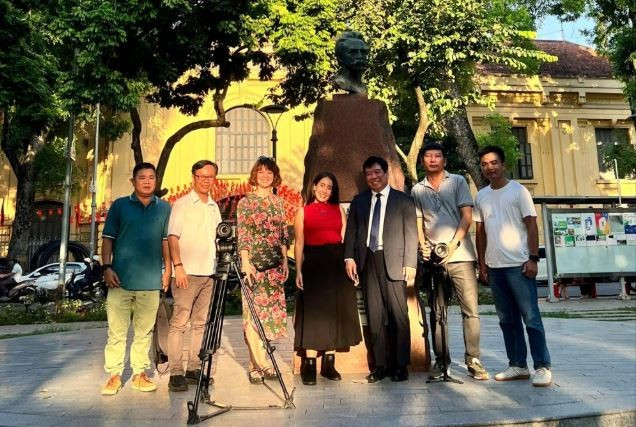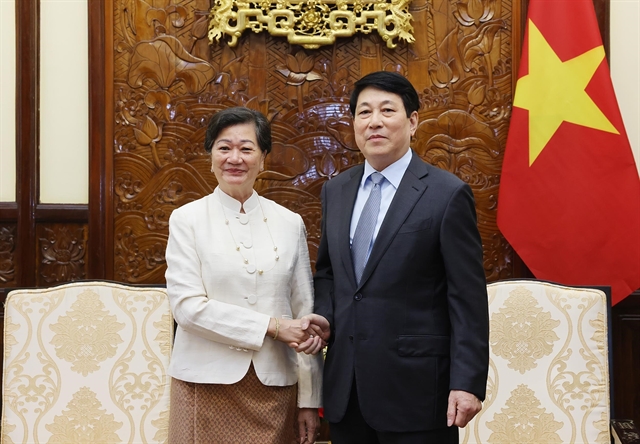 Life & Style
Life & Style


|
| Đất Nước Đổi Mới (Renewing the Nation), oil on canvas. — Photos baotintuc.vn |
HÀ NỘI — A major exhibition titled Nguyễn Đỗ Cung – A Legend is being held at the Vietnam University of Fine Arts in Hà Nội from August 12 to 20 in anticipation of the 100th anniversary of the Indochina College of Fine Arts (1925–2025).
The exhibition, curated by collector Lê Quang Tuyến, features nearly 120 artworks by Nguyễn Đỗ Cung, one of the most revered figures in 20th-century Vietnamese art.
Though only a fraction of his vast artistic legacy, the exhibited works provide art lovers with profound insight into the creative genius and moral stature of the man who is widely regarded as both an artistic pioneer and a cultural visionary.
Born in 1912 and passing in 1977, Cung was not only a gifted painter, but also a leading art scholar and educator. A graduate of the Indochina College of Fine Arts, he belonged to the first generation of modern Vietnamese artists who mastered academic techniques from Europe while pioneering a distinctive national visual identity. He played a key role in founding the Vietnam Institute of Fine Arts and the Vietnam Museum of Fine Arts, and was instrumental in establishing a research-based, Vietnamese-rooted approach to the arts during a critical period of the country’s cultural development.
His artistic vision was shaped by the convergence of East and West. Drawing on both the architectural legacy of ancient Vietnamese dynasties and early 20th-century European art movements like Cubism, Cung developed a distinctly Vietnamese modernist style. His goal was to refresh national aesthetics while remaining grounded in tradition.

|
| A draft sketch of the Portrait of President Hồ Chí Minh by Nguyễn Đỗ Cung. |
Among his most iconic works are Chân Dung Hồ Chủ Tịch (Portrait of President Hồ Chí Minh, oil on canvas, 1946), Khu Di Tích La Hai (La Hai Relic Site, gouache, 1947), Dân Quân Tập Bắn (Militia Training, gouache, 1948) and Học Hỏi Lẫn Nhau (Learning From Each Other, oil on canvas, 1960).
He also authored major scholarly texts, including Khái Quát Nền Nghệ Thuật Cổ Của Nhân Dân Việt Nam (An Overview of Việt Nam’s Ancient Art) and Những Di Sản Kiến Trúc Cổ Việt Nam (Việt Nam’s Architectural Heritage), which remain essential references in the field.
In recognition of his lifelong contributions, Cung was posthumously awarded the First-Class Labour Medal in 1977 and the prestigious Hồ Chí Minh Prize for Literature and Arts in its inaugural edition in 1996.
As an artist, Cung's works are deeply realistic, yet profoundly Vietnamese in spirit. His signature style celebrates labour, resilience and the everyday heroism of ordinary people. Factory workers and militia members, often depicted at the heart of his compositions, embody the strength and determination of a nation in transformation.
He was among the first Vietnamese artists to explore and master the use of lacquer and gouache, blending Western techniques with the richness of local materials. His brushwork is bold and deliberate, and his compositions reveal an acute sensitivity to structure, light and colour. Vibrant yet harmonious, his paintings breathe life into both the characters and the ideals they represent.

|
| Tự Vệ Nhà Máy (Factory Self-Defence Unit), gouache. |
Cung’s legacy also extends into architecture and museum curation. As Director of the Institute of Fine Arts, he led field expeditions to document and preserve Việt Nam’s architectural and decorative heritage, helping to shape the nation's identity through art.
He was also responsible for transforming a former French villa into what is now the Vietnam Museum of Fine Arts, a space he redesigned to echo the aesthetics of a national museum. The legendary artist also mentored the country’s first generation of scholars in ancient Vietnamese art, laying an academic foundation that endures to this day.
Visitors to the exhibition can also explore a new 140-page publication titled Họa sĩ Nguyễn Đỗ Cung (Painter Nguyễn Đỗ Cung), published by the Vietnam Fine Arts Publishing House. The book offers an in-depth look into his life and work, further enriching the public’s appreciation of his contributions.
As Việt Nam looks ahead to celebrate a century of fine arts education, the exhibition Nguyễn Đỗ Cung – A Legend reminds us of a man whose legacy lives not only in canvases and books, but also in the very identity of modern Vietnamese art. — VNS